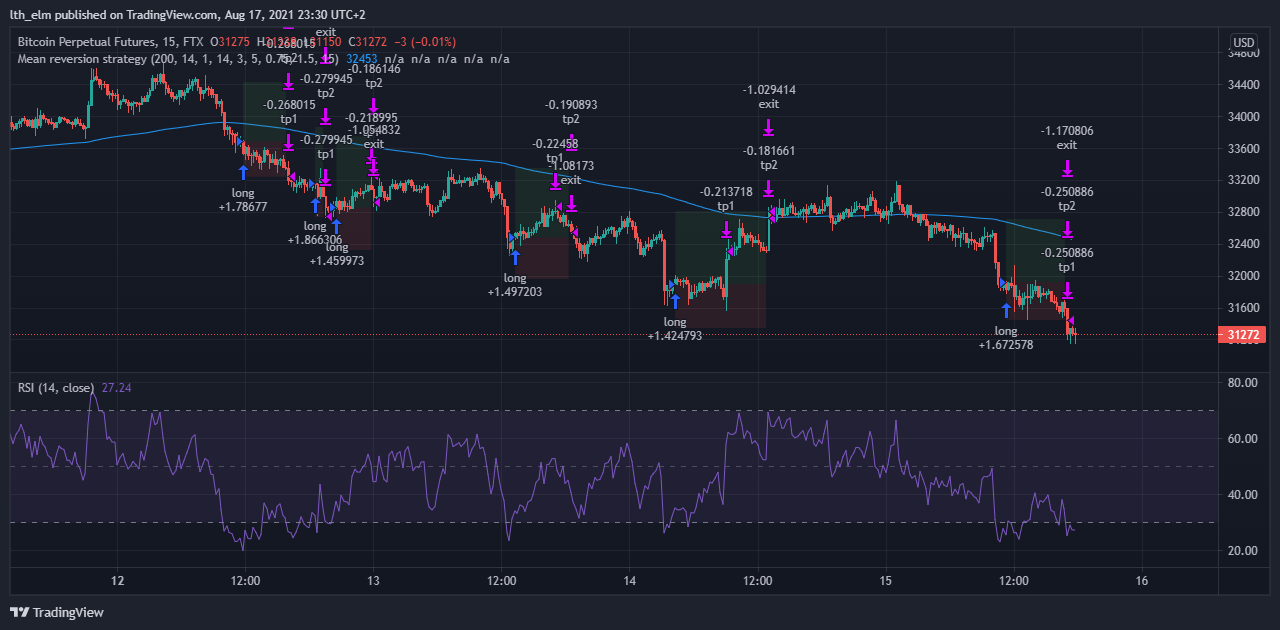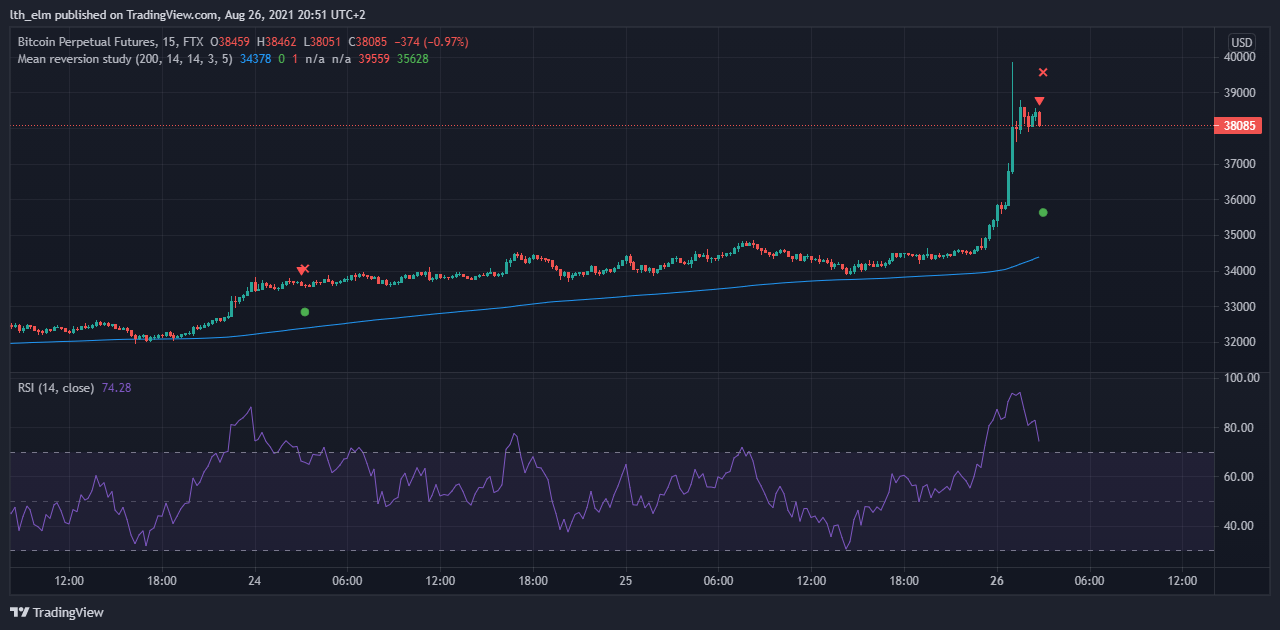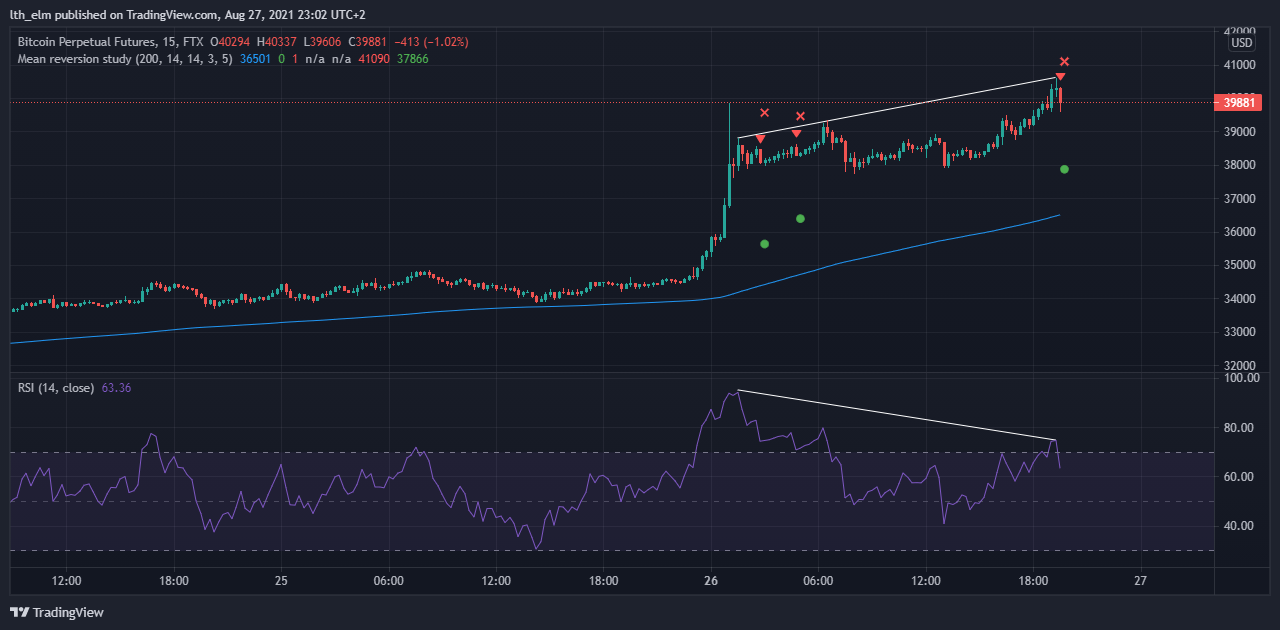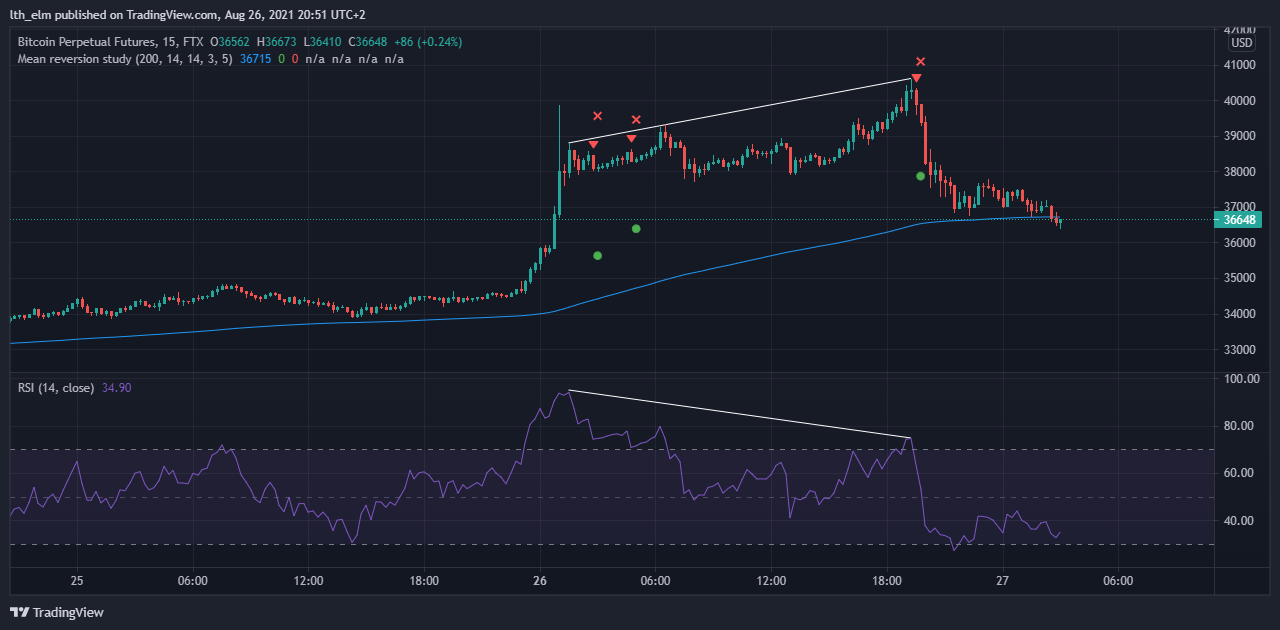If you ever decide to sign up to any of the application please use one of my link as we both benefit from it, thank you.
Also, if you ever notice something that can be improved or corrected or even add a completely new dimension please de not hesitate to pull request.
A Flask app receiving alerts from TradingView and automatically sends a POST order to an integrated exchange API such as FTX and ByBit (Binance to come). Can also deliver the alert and the chart to discord where you can decide whether or not to take that trade through a Discord bot.
In order to build that app I relied on two great videos to get started, implementing and deploying basics stuff, I then enhanced it all for my own use. This one from Part Time Larry https://www.youtube.com/watch?v=XPTb3adEQEE (his github) and this one for the discord bot from freeCodeCamp.org : https://www.youtube.com/watch?v=SPTfmiYiuok.
I won't go into full details so if you're a novice you might want to go through the videos first (at least the first one for the first part) but not necessary if you only want to take a grasp of what's happening here, otherwise if you already master even a bit of Flask, APIs, webhooks and TradingView pinescripts you can easily follow along (I will try to add more technical explanations over time or a glossary).
Fist of all, to be able to use TradingView webhooks you will need to subscribe to the pro plan for approximately 12$ per month (a free month trial is available), and you can use my referral link to sign up so we all save 30$ when upgrading to a paid plan : https://www.tradingview.com/gopro/?share_your_love=lth_elm.
Now that this is done we can get down to business. We will need to write a pinescript strategy that will be for our example focused on mean reversions : if we are above/under the 200 period EMA, RSI is overbought/oversold and we have a bearish/bullish engulfing candle we will either short or long the position trying to come back to the 200 period exponential moving average. For ease of use the stop-losses and take-profits are placed using "random" values of ATR.
Here is the script that I wrote you can have a look (better copy-paste it on tradingview since the syntax highlighting for pinescripts is not yet integrated on GitHub). I added my own touch so I can visualize the stop-loss and take-profit targets on chart.
Of course it is far from being perfect so don't use it for you own trading since it wasn't written for this purpose and it's a strategy going against the main trend (thus very risky). However we will see in part 2 how we can improve it and integrate our own choice thanks to the discord bot.
As you can see we have multiples exit positions and some are even at breakeven, our integration with the FTX api is compatible for this style of trading, you can set the % you want to close for these intermediary TP in the tp_close variable.
However, if you want to keep it to the bottom line you can just set one entry and one fixed exit. For that you will need to uncomment the strategy.exit() lines for both if goLong and if goShort and remove the two following lines:
// Execute buy or sell order
if goLong and notInTrade
size = (strategy.equity*risk) / abs(close-long_stop_level)
strategy.entry("long", strategy.long, qty=size, alert_message="entry")
// strategy.exit("exit", "long", stop=long_stop_level, limit=long_profit_level, alert_message="exit")
inLongPosition := true // to remove
notInTrade := false // to removeAnd delete all the multiple TP category.
// ----- MULTIPLE TP -----
// ...When deciding to take, close or exit a position with strategy.entry/close/exit() you must specify an 'alert_message' that can only be one of those : entry | exit for the minimal basic strategy, tp[n] if you've set multiple take profit level and finally xxx_breakeven anything can be written before the letter 'b' this is just for when this alert is triggered the bot will set a new stop-loss at breakeven level (+ a few % to save comission fees).
Now we can set the alert on TradingView. When you do that you will need to specify the Webhook URL that would be https://the-link-of-your-flask-app.com/your-route, "your-route" would be "tradingview-to-webhook-order" in our example (app.py).
@app.route("/tradingview-to-webhook-order", methods=['POST'])
def tradingview_webhook():Then in 'Message' we write the payload in a json format so that python can read it and extract the information needed. In alertmodel.txt there are multiples formats for alert messages and what results are generated from the placeholders, some includes datas for multiple take-profits : ... "tp Close" : {{plot("TP Close")}}, "tp1 Mult" : {{plot("TP1 Mult")}}, ... ==> ... "tp Close" : 20, "tp1 Mult" : 0.6, .... For a basic impletentation the whole payload whould look like this :
{
"ticker" : "{{ticker}}", // BTCUSD...
"exchange" : "{{exchange}}", // FTX, ByBit, Binance
"time" : "{{timenow}}",
"action" : "{{strategy.order.action}}", // buy, sell
"price" : {{strategy.order.price}},
"message" : "{{strategy.order.alert_message}}", // entry, exit, ...breakeven
"short SL" : {{plot("Short SL")}},
"short TP" : {{plot("Short TP")}},
"long SL" : {{plot("Long SL")}},
"long TP" : {{plot("Long TP")}},
"passphrase" : "abcdefg",
"subaccount": "Testing"
}
- ('//' are only for comments).
- In the python code the tp[n] multiplicator places an intermediary take profit at entering price + |entering price - stop loss price| x tp[n] multiplicator, you're free to change how you want to use it.
- Some exchanges can have subaccounts so you might need to specify the one to use.
- And finally the passphrase is required since anybody can send a post request to your webhook url so you want to make sure to take into account only those coming from your TradingView alerts.
We will now see how our app checks for the password along all the other implementations.
As we've said before we need to set a route that will receive POST requests and load the request data in a json format, so it will be :
from flask import request
@app.route("/tradingview-to-webhook-order", methods=['POST'])
def tradingview_webhook():
data = json.loads(request.data)Then we will need to compare the stored password with the one we received. So beforehand let's fetch it.
webhook_passphrase = os.environ.get('WEBHOOK_PASSPHRASE', config.WEBHOOK_PASSPHRASE)The main password is saved with the Heroku environment variables so we will try to get this one first, however if you are deploying the app locally it won't find it so you will need to write it in the config.py file, otherwise just set it to None.
When that's done we can verify that the payload actually contains a password before check if it is the right one and finally calling the order() function from orderapi.py.
import logbot
if 'passphrase' not in data.keys():
logbot.logs(">>> /!\ No passphrase entered", True)
return {
"success": False,
"message": "no passphrase entered"
}
if data['passphrase'] != webhook_passphrase:
logbot.logs(">>> /!\ Invalid passphrase", True)
return {
"success": False,
"message": "invalid passphrase"
}
orders = order(data)
return ordersThe orderapi python file contains the global variables that we will get : subaccount to use, leverage to use (or not), maximum risk per trade (in %), the api key and api secret. To retrieve them the concept is the same as with the password except that these values will depend according to the subaccount you are using, therefore right at the beginning of the order() function we will call global_var() that will get from the payload the subaccount name and set the values accordingly.
import os, config
subaccount_name = payload['subaccount']
if subaccount_name == 'Testing':
risk = os.environ.get('RISK_TESTING', config.RISK_TESTING)
risk = float(risk) / 100
# ...
elif subaccount_name == 'STRATEGY_TWO':
# ...In accordance with the exchange used in the TradingView strategy exchange_api will take its class, for now only only the FTX have been integrated.
from ftxapi import Ftx
# SET EXCHANGE CLASS
exchange_api = None
try:
if exchange == 'FTX':
exchange_api = Ftx(init_var)
elif exchange == 'An other exchange name'
# ...You need to know that the tickers names in the exchanges and the ones in TradingView might be different, for instance in tradingview the ticker for the BTC/USD future contract of the FTX exchange is BTCPERP while in the FTX app it is BTC-PERP. So for that we have created a json file (tickers.json) that indexes for every exchange its tradingview ticker with its original one.
{
"ftx": {
"BTCPERP": "BTC-PERP",
"ETHPERP": "ETH-PERP",
"FTTPERP": "FTT-PERP",
"BNBPERP": "BNB-PERP"
}
}And the python code :
# FIND THE APPROPRIATE TICKER IN DICTIONNARY
ticker = ""
with open('tickers.json') as json_file:
tickers = json.load(json_file)
try:
ticker = tickers[exchange.lower()][payload['ticker']]Finally one important step before making any post request to our exchange is to know what the alert we received was for. This information is contained in the 'message' key of our payload, remember when we wrote and 'alert_message' that we used as a placeholder in our pinescript and alert message ? Well it's that one and the message can be of 3 types : entry, exit and xxx_breakeven (as long as it finishes with breakeven) and we ignore any other message for information only such as tp[n].
According to the message we will call the appropriate exchange class method.
import logbot
# ALERT MESSAGE CONDITIONS
if payload['message'] == 'entry':
logbot.logs(">>> Order message : 'entry'")
exchange_api.exit_position(ticker)
orders = exchange_api.entry_position(payload, ticker)
return orders
elif payload['message'] == 'exit':
logbot.logs(">>> Order message : 'exit'")
exit_res = exchange_api.exit_position(ticker)
return exit_res
elif payload['message'][-9:] == 'breakeven':
logbot.logs(">>> Order message : 'breakeven'")
breakeven_res = exchange_api.breakeven(payload, ticker)
return breakeven_resFor this part you'll need to sign up to any exchanges for which the api is integrated and retrieve your private and secret keys. The integration of an exchange api is done by creating a new class on a new file, in this case we will use FTX so for that we have create the file ftxapi.py.
First we initialize the instances of the class by passing it the previous variables (subaccount, risk per trade...) and initiate the REST endpoint URL.
from requests import Request, Session, Response
class Ftx:
def __init__(self, var: dict):
self.ENDPOINT = 'https://ftx.com/api/'
self.session = Session()
self.subaccount_name = var['subaccount_name']
self.leverage = var['leverage']
self.risk = var['risk']
self.api_key = var['api_key']
self.api_secret = var['api_secret']The methods unders 'SIGN, POST AND REQUEST' are obviously for authentication and POST and GET requests. The authentification technique is given by FTX, you can find it here alongside the rest of the API documentation : https://docs.ftx.com/?python#authentication
Now under 'ORDER FUNCTION' are written the 3 method class for entering, exiting a position and even a method that has the ability of moving a stop loss to breakeven.
The structure is essentially all the same for the three, we define with variables the action (buy or sell), what quantity (size), at what price, where to place the tp and sl and we regroup them all in a different dictionnary payloads. Depending on the request we need to specify or not somes values so you need to check what is expected for a specific request in the documention.
The position size is calculated as follow so that every losing trade doesn't cost you more than X% of what you are willing to risk from your total amount : size = (free_collateral * self.risk) / abs(payload['price'] - stop_loss). Here the total amount available is free_collateral, risk was automatically converted from % to %/100 and stop_loss is a price value not a difference.
Ok let's suppose that our bot is about to enter in a position, for safety it will first place the stop loss and this is how we code that :
sl_payload = {
"market": ticker,
"side": close_sl_tp_side,
"triggerPrice": stop_loss,
"size": size,
"type": "stop",
"reduceOnly": True,
"retryUntilFilled": True
}
r = self._try_request('POST', 'conditional_orders', sl_payload)
if not r['success']:
return r
orders.append(r['result'])How can we know that the payload has to be written like that and that the we want to post to the url 'ENDPOINT/conditional_orders' ? Well simply by looking over the documentation :
https://docs.ftx.com/?python#place-trigger-order
By scrolling down the file you can quickly have an idea of all the things that are possible (posting limit orders, multiple take profits etc...). From and exchange class to another you'll probably need to change in these three methods the payloads'keys and values, the urls and how you access a value from a json you've retrieved.
You must have notice in some part of the code lines similare to these ones :
import logbot
logbot.logs(">>> Order message : 'entry'")
# or
logbot.logs(">>> /!\ Invalid passphrase", True)This logs() function from logbot.py act as a console log printer but also sends the logs to a discord channel you've specified so that you can easily at any time track your bot's actions.
You can create another channel for error logs where you would set notifications to high priority so that you will be quickly aware if anything goes wrong.
To do that it's pretty simple, you'll have to send a json post request to the discord webhook (Discord server settings / Integrations / Webhooks / New webhooks) which must contain a username, a content and optionally an avatar. If an error has occured you just set the error variable to true and the message is also send to the error channel.
import requests
DISCORD_ERR_URL = "https://discord.com/api/webhooks/xxxxx"
DISCORD_LOGS_URL = "https://discord.com/api/webhooks/xxxxx"
logs_format = {
"username": "logs",
"avatar_url": "https://imgr.search.brave.com/ZYUP1jUoQ5tr1bxChZtL_sJ0LHz7mDhlhkLHxWxhnPM/fit/680/680/no/1/aHR0cHM6Ly9jbGlw/Z3JvdW5kLmNvbS9p/bWFnZXMvZGlzY29y/ZC1ib3QtbG9nby00/LnBuZw",
"content": ""
}
def logs(message, error=False):
print(message)
try:
json_logs = logs_format
json_logs['content'] = message
requests.post(DISCORD_LOGS_URL, json=json_logs)
if error:
requests.post(DISCORD_ERR_URL, json=json_logs)
except:
pass
This is the most interesting part of the project, the idea behind it is instead of having a TradingView alert triggering our bot and automatically placing an order the alert will instead be sent to a Discord channel with a url link to the chart (ideally we would directly sent the chart image if any of you has an idea about how to do that) so that you can visualize it first and by writting a specific line in this discord channel you can accept to place that order and even bring some modifications to it.
Let's have a concrete example !
Okay so for this example remember when I said here that this strategy is far from being perfect but it can be improved if we add our own reasoning to it ? Well indeed you can filter the trades and add more weight to your decisions if a regular divergence occurs for example, however many mistakes can happen if you try to code it so it might be better if you analyse it by yourself.
At some point the chart looked like this with an alert triggered.
The chart url will thereby be sent to the discord channel so that everyone can debate (ideally directly send an image instead of a link).
The TradingView alert contains the link toward the chart and a prepared payload anyone can just copy-paste to place an order and may modify it a bit.
Kakkkashi feels good about this trade but Yud_4 suggest him to wait another alert and see if they can notice a divergence in the RSI (Relative Strength Index) and actually after a little while we have one :
You see that if we have taken the first two trades we would have lost.
As you can see price makes higher highs while RSI is making lower highs (the white line has been manually placed for illustration). An RSI divergence demonstrate that the price is losing its momentum and the trend is slowing down, this can be a "perfect" reversal signal for our mean reversion strategy.
Let's see how the other two react to this one.
Here after a simple command !payload Yud_4 was able to place the order after making a small modification to the market type (limit -> market). He then received a confirmattion through the bot that everything went accordingly, should an error occur he would also be aware of that and could check the error logs for more information.
Finally they did well selecting that trade as it was a winner.
* This conversation example has been set up since the alerts occured in the past when this was done.
For this part I got my inspiration from this video it explain pretty well how to create the bot from the Discord developer portal and get and use its token but also how to keep the bot running by ping it every 5 minute so that it doesn't enter in sleep mode.
You will still need to set a tradingview alert so that you won't need to look at the chart everytime, however the strategy script need to be converted to a study one in pinescript and here is how it look like after conversion : Quick-Mean-Reversion-Study.pine
The alert message needs to be modified a bit, here is how it will look like if set for a long position (buy) :
{
"ticker": {{ticker}},
"exchange": {{exchange}},
"action": "buy",
"type": "limit",
"price": {{close}},
"message": "entry",
"long SL": {{plot("Long SL")}},
"long TP": {{plot("Long TP")}},
"passphrase": "abcdefg",
"subaccount": "Testing",
"chart_url" : "https://www.tradingview.com/chart/jbSLq0oe"
}
As you can see it's very much similar to the first payload but we've also added the chart url so that it can directly be sent in the discord channel along the other parameters.
The webhook url also need to be changed to https://the-link-of-your-flask-app.com/tradingview-to-discord-study since this is how it is set in app.py.
@app.route("/tradingview-to-discord-study", methods=['POST'])
def discord_study_tv():This lattest route works almost exactly as the first one except instead of calling the order function to place an order it will call study_alert() from logbot.py. Like logs() study_alert(json.dumps(data), chart_url) send messages to a specified discord channel including the payload and the chart url.
import requests
DISCORD_STUDY_URL = "https://discord.com/api/webhooks/xxxxx"
study_format = {
"username": "Tradingview Alert",
"avatar_url": "https://pbs.twimg.com/profile_images/1418656582888525833/p4fZd3KR_400x400.jpg",
"content": ""
}
def study_alert(message, chart_url):
try:
json_logs = study_format
json_logs['content'] = ">>> " + message + " \n\n" + chart_url
requests.post(DISCORD_STUDY_URL, json=json_logs)
except:
passThe discord bot files is not hosted on Heroku but instead Repl.it however you can still find them here under ./discord_bot/.
Our discord bot will read every message sent to the chat and if one start with !payload it will load what comes next as a json and add to it the webhook passphrase needed by our app for which it will send a post request including the payload.
import discord, requests, json, os
WEBHOOK_URL = os.environ['WEBHOOK_URL']
WEBHOOK_PASSPHRASE = os.environ['WEBHOOK_PASSPHRASE']
client = discord.Client()
@client.event
async def on_message(message):
if message.author == client.user:
return
msg = message.content
if msg.startswith('!payload '):
data = json.loads(msg[len('!payload '):])
data['passphrase'] = WEBHOOK_PASSPHRASE
await message.channel.send('Payload received, now processing...')
success = post_tradingview-webhook(json.dumps(data))
if success:
await message.channel.send(':white_check_mark: Order posted with success !')
else:
await message.channel.send(':x: An error must have occured, please check the logs for more information...')
client.run(ORDER_BOT_TOKEN)That same bot that received the payload will sent intermediary messages to the discord channel to inform the user about the progression and result : order posted with success or error.
- TradingView :
https://www.tradingview.com/gopro/?share_your_love=lth_elm for both saving 30$ when upgrading to a paid plan.
- FTX :
https://ftx.com/#a=26368756 and you receive a 5,00 % fee discount on all your trades.
- Binance and Binance future:
https://accounts.binance.com/en/register?ref=MJB86NYU to save 10% comission fee.
https://www.binance.com/en/futures/ref/154947021 for binance future and to also save 10%.
If it was interesting and you've learned something feel free to support me by sending any amount of cryptos to one of the following addresses :)
-
Ethereum, Matic Mainet and BSC : 0xa1eF4B0eA4f2a45Dc60baba368BDB8656B6fD580
-
Solana : 2c1F4Rs63nL1VCuLP7Qz776X1NemfNUfYjMWTALQzrwh
-
Bitcoin : 3DXrC7ZXxYa4bFbjL3ofgWxfeeiAzzHWf4
Thank you for reading all the way through !



